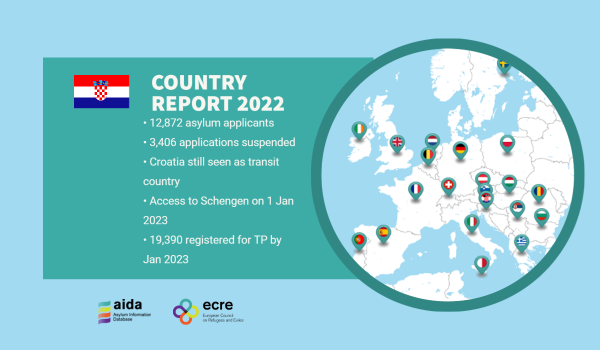The updated AIDA Country Report on Croatia provides a detailed overview on legislative and practice-related developments in asylum procedures, reception conditions, detention of asylum seekers, content of international protection, as well as procedure for and content of temporary protection in 2022.
Reports of pushbacks and violent police practices at the border were still documented in 2022. According to the Danish Refugee Council (DRC), 3,461 persons were pushed back from Croatia to Bosnia and Herzegovina (BiH), while UNHCR data further indicates that 289 persons were pushed back from Croatia to Serbia in 2022. The Ombudsperson for Children reported that at least 120 children were pushed back in 2022 according to data provided by the Border Violence Monitoring Network’s. The actual number is however possibly higher.
The number of applicants for international protection increased significantly throughout the year, going from 3,039 in 2021 to 12,872 in 2022. Among them, 59.5% were men and 40.5% were women. Out of the total number, 37.1% of applicants were children. The recognition rate remained low, as only 21 persons were granted refugee status; 82 applications for international protection were instead rejected and 3,406 were suspended. Observing statistics, it is possible to affirm that Croatia continues to be seen as a transit country, as the majority of applicants leave before receiving a decision on their asylum application. According to the report of the independent monitoring mechanism covering the period June 2021-June 2022, approximately 80% of persons who applied for international protection and were therefore accommodated in the Reception Centre for Applicants for International Protection in Zagreb had left the Reception Centre and their proceedings were subsequently suspended.
Regarding the reception of asylum seekers, the renovation of the Reception Centre for applicants of international protection in Kutina was completed in 2022, and the capacity for accommodation of applicants was increased to 140 persons. Some positive developments could be observed in the inclusion of beneficiaries of international protection. While a new Integration Action Plan was not adopted in 2022, progress could be observed at the local level. In January 2022, the Assembly of the City of Zagreb adopted its Action Plan for the integration of applicants for international protection and persons granted international protection for the year 2022, making Zagreb the first unit of local and regional self-governments in the country having adopted such a strategic document.
The country also received many people displaced from the conflict in Ukraine. According to official data, between 25 February and 31 December 2022, a total of 22,407 displaced persons from Ukraine entered the Republic of Croatia, almost half of them being women and one-third of children. Those registered for temporary protection at the end of January 2023 were 19,390. Beneficiaries of temporary protection enjoy a wide range of rights in the Republic of Croatia, and no significant obstacles to their realization were observed due to the fast reaction of the authorities and the early establishment of an effective reception and care system. By amending the Law on Social Welfare, beneficiaries of temporary protection gained the right to receive all social services and benefits provided for by law under the same conditions as Croatian citizens.
While not directly linked to the national asylum system, an important development in 2022 was the country’s access to Schengen and Eurozone, effective as of 1 January 2023. The Law on State Border Control was amended in 2022, with the aim of adapting that act to the Schengen Acquis.
For further information:
- Find comparative information in the Asylum Information Database (AIDA) managed by ECRE

